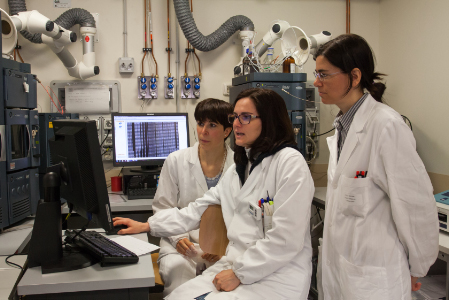Integrin activation plays a central role in the regulation of leukocyte trafficking. Integrin activation also determines the behavior of leukemia cells by controlling both the emigration from the bone marrow as well as the metastatic dissemination to different organs. Rapid integrin activation is regulated by very complex intracellular signal transduction mechanisms triggered by classical chemoattractants and chemokines. These signaling mechanisms are organized in pro-adhesive signaling modules, likely conferring cell specificity to the process of adhesion triggering. We have recently discovered the critical role of a rho-based signaling module triggered by chemokines and controlling integrin activation in a conformer-selective manner. Importantly, we have found that the nature and regulatory role of this signaling module differ in neoplastic B-CLL lymphocytes isolated form patients with respect to normal primary B-lymphocytes. Furthermore, we evidenced patient-specific variations. As a picture of extreme complexity is emerging from these recent findings, novel questions are also rising concerning the nature and the cell subset specificity of the signaling events controlling integrin activation.
In this project we intend to further characterize intracellular signaling mechanisms selectively controlling the adhesion of neoplastic CLL lymphocytes, which may represent new potential targets for pharmaceutical treatment of lymphocytic leukemia. We will compare signaling mechanisms controlling integrin activation in normal primary lymphocytes versus neoplastic lymphocytic cells derived form CLL patients. Integrin activation will be analyzed in the context of the β2 integrin LFA-1 by means of in vitro adhesion assays under static and under flow conditions and by using LFA-1-specific reporter monoclonal antibodies to study heterodimer conformational changes corresponding to distinct affinity states for ICAM-1. The main focus will be on signaling events triggered by the chemokine CXCL12, the ligand for CXCR4 chemokine receptor. We will pursue a further characterization of the rho small GTPase-dependent signaling module, by first investigating in normal T- and B-lymphocytes the role of the phosphatase OCRL, a CDC42 downstream effector, the potential relationship between Talin1 and PIP5KC and the upstream regulatory role of the PTK Jak2, by means of three complementary, fully established, functional interference technologies, including Penetratin-1 and TAT-derived trojan peptides, and a siRNA-based gene silencing approach coupled to a nucleofection technique. This first phase will allow a deeper characterization of signaling mechanisms activated by CXCL12 and controlling LFA-1 triggering and dependent rapid adhesion in normal lymphocytes with specific emphasis on regulation of phosphoinositide local accumulation and on protein tyrosine phosphorylation. In a second phase we will investigate the specific involvement of these signaling events in the regulation of LFA-1 activation in neoplastic lymphocytes isolated from the blood of CLL patients. Finally, in a third phase, we are going to perform a high throughput phosphoproteomic analysis by means of antibody microarrays and of bioinformatic network analysis, by comparing normal to neoplastic lymphocytes of the same leukemia subset but derived form several patients to investigate, in agreement with recently published findings, the potential occurrence of individual heterogeneity in the signaling mechanisms controlling integrin activation in neoplastic cells.
The development of this project will allow deeper characterization of the signaling mechanisms specifically controlling integrin-dependent adhesion in neoplastic versus normal lymphocytes. By studying phsphoproteomic networks triggered by chemokines and related to integrin activation we will be able to identify groups of patients showing divergent pro-adhesive signaling mechanisms and, thus, to classify the patients of the base of heterogeneity in pro-adhesive signal transduction mechanisms. Our analysis will be potentially useful to correlate signaling heterogeneity to clinical data regarding aggressiveness of leukemia and response to therapies, and to develop more selective, efficacious and, possibly, personalized pharmacological treatments of leukemia diseases.







